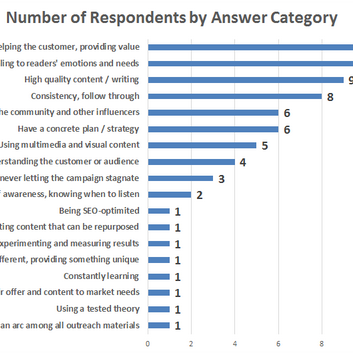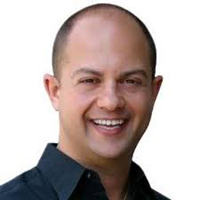I find habits really interesting. One of my favorite recent reads was Charles Duhigg’s excellent book on the subject. I love Nir Eyal’s blog on behavior engineering. One of my favorite interview series is Copyblogger’s look at how smart people write.
Because there are so many different ways to “win” and get traction in content marketing (and because “winning” and “traction” means so many different things for different people) we got input from a large number (68, like the headline says) of people with their take on the following question:
“What is the #1 habit of highly successful content marketing campaigns (i.e. what do businesses that have success with content marketing do well consistently)?”
You can see the full answers of every respondent below, but we’ve also categorized each answer to see what common themes emerged from what folks thought was the most important habit of successful content campaigns:
Meet Our Panel of Marketers:
 Chris Parente
Chris Parente
Chris Parente is the Founder StoryTech Consulting, a business consulting firm that helps B2B and B2G companies tell their own story and promote it directly to their target audiences. His work has appeared in MarketingProfs, E-Commerce News, CommPro.biz and Social Media Today. Today, he publishes a monthly column for WashingtonExec.com, and serves on the marketing committee of the Association for Corporate Growth, National Chapter.
In my opinion, the most critical thing, or habit, that leads to marketing campaign success is for a company to…
Embrace the mindset of a publisher, and embrace the fact they need to give something of value away (information, expertise), before asking anything of a prospect.
There’s a lot more of course — high quality content, promotion, effective analytics and goal tracking on the back end — but that’s the cultural starting point.
 Debbie Williams
Debbie Williams
Debbie Williams is Co-Founder and Chief Content Officer of SPROUT Content, a content marketing agency for B2B companies. She is driven to connect people and businesses through engaging, purposeful content and inbound marketing strategies that deliver results and build relationships.
When it comes to habits of successful content marketing campaigns, businesses that succeed with their content marketing plan…
Have just that, a plan.
They have a documented strategy across all channels, mapped to specific goals, which can be measured and improved upon. If you can’t measure it, how do you know it’s working?
 Bill Harper
Bill Harper
Bill Harper is Co-Founder and co-creative leader of advertising agency Immortology in Chapel Hill, N.C. With two decades of experience, Harper’s specialty is launching, developing and revitalizing brands by finding ways to outsmart, not outspend, their competitors. Earlier in his career, Harper honed his art direction and strategic skills on work for Anheuser Busch, Enterprise Rent-A-Car, Michelin, Blockbuster Video, Denny’s, Lance Snack Foods, Go RVing and Mitsubishi Electric. His work for these brands has been recognized by almost every industry awards show, and featured in publications like Print and Communication Arts and in numerous newspapers, blogs and trade magazines.
The number one thing that good content marketers consistently do is…
Write well.
Unfortunately, writing well is hard. Fortunately, with practice and over time, it gets easier. And no, writing well doesn’t mean writing fancy.
Here are four good habits good content marketers share with good writers. What they boil down to is: be focused, be useful, be engaging and be brief. Specifically:
- Stay on brand. You cannot be all things to all people, and if you try, you will fail. Remember that content marketing is still marketing, which means its purpose is to show leadership within the category. Cover topics you know better than anyone, and, unless you¹re Weather.com, don¹t kid yourself that you¹re having a relationship with your readers by talking about the weather. You¹re wasting your time and theirs.
- Know your target audience, and give them content that either makes their lives easier, increases their social capital orcareful hereentertains. How? Learn what really bugs your readers and tell them how your product can fix it (and your competition can¹t or won¹t). Don¹t know? Ask. Chances are what bothers one potential client, bothers many. Help your readers connect the dots. Tell them something new about your topic, something they can ponder and, maybe even, use to impress their bosses, colleagues or friends. They’ll feel good. People like feeling good. As a last resort, entertain. This is YouTube’s turf so unless you’ve got something directly tied to the brand, stick to points one and two above. That said, if your brand is doing something really amazing, share away.
- Put some thought into it. The Internet is full of repackaged contentmuch of it unhelpful to begin with. If you¹re forwarding content, do something new with it. Have an opinion, challenge people¹s POV, give them something new to consider.
- Be brief. Avoid jargon. Edit. Few things numb the brain faster than wandering phrases like, robust synergies that streamline sustainability. Gag me with a Webster. Get on with it already.
 Domenick Cilea
Domenick Cilea
Domenick Cilea is the President of Springboard, a marketing and public relations firm based in central New Jersey. Founded in 1995, Springboard develops public relations, marketing and social media campaigns that deliver results. The firm has worked with hundreds of start-ups and supported the establishment of technology, Internet, telecom, and software companies.
Brands that have the most success with content marketing campaigns understand one thing, which is…
Consistency.
Successful companies have a strong voice, amplify content regularly using social media channels and keep their brand consistent across all of their marketing materials. The purpose of content marketing is to attract customers by creating meaningful and relevant information and present it within an array of formats.
The pros don’t just push out a good piece of content in one big blast, but instead create evergreen content that solves the problems of their audience members and can be consistently shared over time. When brands deliver consistent, valuable content customers continue to be loyal.
 Gina Rau
Gina Rau
Gina Rau is the Founder and Brand Strategista at Mighty Big Impact. In her leadership role, Gina helps companies (big and small) define their authentic brand, get their positioning just right and share it with their ideal audience to see mighty big impact in their business.
This is such a great question because I truly believe (and have witnessed it to be true) that certain habits are what defines consistently successful content programs. Here’s what I mean…
Companies that can develop a culture of story gathering are well-positioned for content success for a number of reasons. Capturing stories is often one of the biggest challenges for the internal content manager. It’s not a one-man task, but is often a one-man gig. They need an army of people, especially on the front line talking to customers, partners and vendors, seeking the stories they’re not event aware of. There’s gold in those stories and they need to be told — but first they need to be revealed.
When the entire organization is contributing story ideas, there is a sense of ownership and pride that carries through. Employees can be hesitant to mix business and pleasure, meaning they don’t always want to promote their company’s marketing efforts with their social network. When they, or co-workers, have contributed, the story suddenly doesn’t feel like marketing and they’re eager to show off the great place they call work.
Developing this culture of story gathering relies on the habit of capturing moments, quotes and anecdotes as they happen, across the entire organization. The content manager must make it super easy for people to simply submit an idea — that’s it. Asking people to create the content is the #1 reason (excuse) why people won’t contribute ideas. For a smart, experienced content creator, tracking down details of the story and bringing it all together is the easy part!
 George Fischer
George Fischer
George Fischer is Vice President of Earned & Emerging Media at Response Mine Interactive, an online marketing agency specializing in customer acquisition strategies, and effective lead generation strategies. In his leadership role, he is responsible for the revenue and profitability growth of RMI’s organic search, content marketing, social media, and native advertising offerings. In an ever-changing digital landscape, George helps clients evolve their earned media strategies to drive incremental revenue and acquire new customers. He brings true industry thought leadership and expertise to RMI clients, having authored some of the industry’s most popular content. George has a proven track record of delivering award winning results for industry leaders such as Carter’s/OshKosh B’Gosh, SPANX, Liberty Medical, Navy Federal, Terminix, Trugreen, and The Home Depot.
The #1 habit of highly successful content marketing campaigns is…
A concrete strategy.
Businesses need to identify one or two key objectives to base all of their efforts on. They need to target a specific group of people and have clear goals. Content marketing fails when there is no set strategy or when the strategy is too loose. The purpose of content marketing is to bridge the gap between the business and the consumer-to make the consumer trust and engage with your brand. And without clearly identifying who your audience is and what you are hoping to achieve, your business will not succeed in content marketing.
 Matthew Sommer
Matthew Sommer
Matthew Sommer is the COO of Brolik, a digital agency focused on web design, digital strategy, branding and video. As COO, Matt handles all of the day to day operations at Brolik, ensuring that the team has the resources and tools needed to grow and streamline internal processes. Matt also leads digital strategy projects, helping to guide research and optimization for ongoing campaigns.
The only way to successfully market your content, and a habit that successful content marketers have in common, is to…
Jump right into the community and get involved.
I see far too many businesses trying to push their content in from the outside, when it’s far easier and more effective to become active in the community and push out from the inside. Not only does this allow you to grow trust and good will with the community that you want to help you amplify your content, but it also provides you a much better perspective on what type of content or topics the community is interested. Don’t stay isolated behind your computer screen! Get your swim trunks on and come on in, the water’s fine!
 Frances Reimers
Frances Reimers
Frances Reimers is the Director of Corporate Visibility at PCI, an award-winning marketing agency serving national and regional corporate, not-for-profit, and government clients from our Washington, DC area headquarters. PCI specializes in audience engagement, helping clients achieve their goals through powerful communications strategies and solutions.
The most successful content marketers are those who are able to…
Develop an arc amongst all of their outreach material.
It’s not just about propelling your brand, but weaving a narrative throughout all of your work that truly demonstrates your value proposition. That way when someone receives your piece they aren’t just engaging with a one-off, but a small part of a larger body of knowledge.
 Simon Slade
Simon Slade
Simon Slade is CEO and Co-Founder of Affilorama, an affiliate marketing training portal with 230,000 members and over 100 free video lessons, many of which focus on how to successfully employ content marketing to support your e-commerce business.
The most successful content marketers make their primary goal to…
Inform and help their customers.
Yes, we engage in content marketing to increase sales, but if you allow that to be the focus of your content, potential customers will think you are there solely for your own benefit and won’t trust you as a credible source. On the flip side, if your primary focus is providing quality content that potential customers can use and benefit from, you’ll earn their loyalty and trust, and sales will naturally follow.
 Jacob Baldwin
Jacob Baldwin
Jacob Baldwin is the Global Manager of Digital Marketing at Emerson Climate Technologies. Over the past several years, he has been recognized as an emerging expert in the field of digital marketing, speaking at multiple national industry conferences and contributing to numerous notable industry publications.
The #1 habit of highly successful content marketers is…
A solid, tested, and verified customer theory.
A customer theory represents a collection of thoughts, feelings, understandings, and assumptions about your customers’ rationale and factors that influence decision making processes, however minor or major. Whether it’s a conscious decision to open an email or make a purchase. If content marketers understand what makes their audiences tick – that is – if they know what they care about, what they’re interested in, and what information they want, the marketer will be more likely to craft wildly successful campaigns than someone who simply got lucky.
 Alexis Grant
Alexis Grant
Alexis Grant is Innovator-in-Chief of Socialexis, a content marketing firm that specializes in managing blogs.
I run a small content marketing firm that specializes in managing blogs. When people ask me what they need to do to be successful with content marketing, I don’t tell them to be consistent about one thing, I tell them…
To be consistent, period.
All the successful brands offer value on a consistent basis, week after week after week, without big lags, so their readers expect to hear from them and want to hear from them.
If they know they’ll get something awesome when they visit your site, they’ll come back. They’ll open your emails. They’ll click through on Facebook. That consistency is essentially following through on your promise to your readers, that you’ll continue to help them over time.
 King Hill
King Hill
King Hill is a Senior VP and Digital Strategist with Marcus Thomas LLC, a marketing communications agency with offices in Cleveland and Buenos Aires, Argentina. In 2014, Marcus Thomas was recognized in the Content Marketing Awards as one of the world¹s top eight content marketing firms, for its work for Sherwin-Williams Diversified Brands.
The #1 habit of highly successful content marketers is they…
Always align what they have to offer, their content, with the changing needs of the marketplace; for them, it’s a conversation responding to the ebb and flow of the marketplace.
 Vladimir Gendelman
Vladimir Gendelman
Vladimir Gendelman is Founder and CEO of Company Folders, an innovative presentation folder printing company.
We’ve been incredibly successful at marketing our content, particularly on social media. Our blog gets over 125,000 visitors each month. We attribute our success to the following habits:
- Write an amazing post every single time. Research thoroughly and ensure that each post is comprehensive.
- Create awesome images to illustrate each point of your post, so awesome that other bloggers want to steal them from you.
- Create great, eye-catching featured images and engaging, intriguing headlines for your social promotions.
- When you advertise on social media, make sure you target the people who want to see and share it.
 Maire McMahon
Maire McMahon
Maire McMahon is a Senior Account Executive at 10 Squared, a full-service marketing communications agency based in Atlanta, GA specializing in fashion, beauty lifestyle and entertainment brands.
Through my experience both first-hand and through constant trend analysis of the marketing industry, the #1 habit of highly successful content marketing campaigns is…
Storytelling. Tell a story that people will actually care about. Thats all.
“Content is anything that adds value to the readers life.” – Avinash Kaushik
 George Potts
George Potts
George Potts is Vice-President, Director of Social Media at the advertising agency Brunner, and is the leader of the agency’s social media discipline, comprised of cross-functional teams from advertising creative, public relations, media, and digital, all focused on delivering social media ideas and solutions that further client goals. He advocates a “social by design” philosophy, that begins with consumer insights and from there, applies social engagement strategies and tactics that will drive content virality and increase brands’ social currency. Potts’ national brand experience includes: Aquafresh, Bob Evans, College Inn, Cub Cadet, Del Monte, DeVry University, Mattel, Nestle Drumstick, Olympic Paints & Stains, Skinny Cow, Stouffer’s, TUMS and Zippo, among others.
Successful content marketers’ number one habit is…
Not constantly talking about themselves.
If your sole focus has been promotional content, then it’s time you widen your mission, to what is sometimes called brand publishing..
Think about it like a cocktail party. If all you do is talk about how great you are, you will be seen as a jerk. A business participating in content marketing is no different.
Your business, your brand, needs to credibly tap into your fans’ and followers’ the broader interests. Find content beyond your product or service that will they find compelling… and that they will welcome coming from your business. Operate like a magazine publisher does. Establish a publishing mission and content pillars. What will you help your readers do or achieve? What content will achieve these goals? Are you sincere in offering this content to its readers?
Successful content marketers use this type of approach to drive social awareness of their business. And, by tapping into their market’s broader interests, to raise consideration of their business over others in their category.
 Carly Fauth
Carly Fauth
Carly Fauth is the Director of Marketing & Outreach for MoneyCrashers.com, an online community for people striving to make financially sound decisions.
The number one habit of highly successful content marketing campaigns is…
To focus on high quality content.
There are too many other facets of content marketing such as identifying your target audience and promoting your content that lots of folks think that just throwing content of any sort of quality is OK
as long as you’re taking all the other steps. That is simply incorrect.
You need to invest as much time in creating your content as you do everything else – your articles should have compelling titles with attention-grabbing openings, your content overall should be brief and concise, and you should focus on stuff that is of interest to your audience that they might not be able to find anywhere else. When you make content creation Point #1 and then move on to all the rest, your chance of success do go up.
 Jason Parks
Jason Parks
Jason Parks is Owner of The Media Captain, a Columbus digital marketing agency focused on creative and result-driven solutions for companies of all sizes.
The most important habit of a highly successful content marketing campaign is…
A stellar strategy that will drive the content.
A great idea behind a campaign is what will entice people to read and share the content. Regardless of how much time is spent on content marketing, if you don’t create great material, you will not be successful. This is why the strategy is crucial.
 Holly Rollins
Holly Rollins
Holly Rollins is the Founder and CEO of 10-x Group, a full-service content marketing and PR agency, and has more than 20 years experience in marketing and public relations. As 10-x Group CEO for 12 years, she has created successful content marketing and digital marketing/PR for diverse sectors–from national to regional clients. She and her seasoned team know the foundation for marketing and PR success and the perfect balance for integrating these best practices with content marketing to make companies STAND OUT. Learn more about Holly and her work on her blog www.hollymrollins.com.
The #1 habit of highly successful content marketing campaigns (ie what do businesses that have success with content marketing do well consistently) is…
They feature relevant, compelling (and strategic) content to their target audiences’ prime social channels (or the social media channels of greatest influence for their target markets).
 Blaise Lucey
Blaise Lucey
Blaise Lucey is the Content Marketing Manager for Movable Ink, a real-time email marketing platform. He’s in charge of creating content that helps customers and prospects better understand how Movable Ink can work for them, as well as keeping tabs on the latest developments in the contextual marketing space.
When creating a content marketing campaign, successful businesses always make sure that…
None of the content is a dead end.
That means creating content that always has a next step and a call-to-action. If you have a blog post, for example, it should have a call-to-action to a gated piece of content like an eBook, a research report, or a webinar. Premium content like eBooks and webinars should invite people to sign up for a demo, an email address, or something else that continues the dialogue.
 Swetha Venkataramani
Swetha Venkataramani
Swetha Venkataramani is Content Marketing Associate at 9Lenses, Inc., the first enterprise SaaS platform that has productized the process of capturing insights of employees & customers, accelerating and automating how companies move from human insights to value-creating actions. Swetha started her career as a journalist in the United Kingdom and in India, before moving into a content writer role in the PR industry. Since then her passion for content marketing steadily grew, and she has had the opportunity to work with non-profits both as a writer and marketer, with special focus on social media marketing.
Most people believe that content marketing is mostly about creating content and marketing it. But, truly successful content marketers, content marketing teams, and content marketing campaigns have one habit in common…
They are constantly learning!
The most successful campaigns have the ability to engage the audience, get the audience to interact, and learn from what the audience is saying. Based on the responses from the audience, a campaign can further be fine-tuned for the better and will also have a better chance to grow organically. In my team, we constantly improve our content and content marketing campaigns based of what we learn from our audience’s response (and sometimes the lack of response!)
Contrary to the popular belief, the best content doesn’t just come from good writing, but is also rooted in the amount of listening and learning that happens before the actual content is produced.
 Campbell Macdonald
Campbell Macdonald
Campbell Macdonald is CEO and a Founder at Pathful which shows marketers the business impact that content marketing has along the customer journey.
The number #1 habit of highly successful campaigns is just that:
They are a habit.
Too often, content marketing is thought of as a one-off project and not a program that requires a commitment. Content is a long term investment that pays dividends, but not in the short term. So successful campaigns are not normally the result of a stroke of genius. Rather they are normally the result of:
- cultivating an audience
- learning from past campaigns what has worked and what doesn’t
- measuring the results
- then launching the next campaign based on that acquired knowledge.
Not sexy, but simple and highly repeatable.
 Barney Cohen
Barney Cohen
Barney Cohen is the President and CEO of Business 360 Northwest, a business consulting firm that provides a wide array of business services to help you grow your business. He has more than 40 years of experience in starting and operating businesses. From a single retail record store, Barney built one of the largest wholesalers of prerecorded music in the world. He specializes in helping businesses manage their growth and take their business to the next level.
By far the most important aspect of content marketing and a habit that the most successful campaigns have in common is…
Consistency.
Many businesses focus on the quality of the content, and certainly that’s important. But if you are not consistent in getting content out, it will be impossible to gain a following. Consistency suggests that you are committed to your business and on top of your game. Inconsistency suggests the opposite.
Once you gain a following that is reading your content – such as a blog or newsletter – those followers will expect to see your material. If you are consistent, in all likelihood, they will continue to follow you, and if you’re not consistent, they will stop following you. It’s really as simple as that.
You get to decide what is consistent for you. It doesn’t have to be every day or even every week. For me, I blog twice a week and send out a newsletter once a month. That feels like the right frequency for my followers.
 Marci Hansen
Marci Hansen
Marci Hansen is a Co-founder and Chief Marketing Officer at SheerID, the leading eligibility verification servic provider. Marci has over 15 years of marketing experience. Before co-founding SheerID, she served as Vice President of Marketing at Palo Alto Software and Crafts Americana Group where she created content-based marketing strategies. She also created innovative marketing campaigns in her positions at Dotster, People for the Ethical Treatment of Animals, Amazon.com, and Eddie Bauer. Marci was rewarded for her work with the Guerilla Marketer of the Year award from Brandweek magazine in 2006 for her efforts on peta2, the youth marketing campaign of PETA.
Since our clients want to reach very specific markets like college students, military personnel, and teachers with exclusive offers, we had to find a way to receive insight into these target audiences to capture the attention of companies that would be interested in SheerID’s eligibility verification services. We discovered that the key to creating successful content marketing campaigns was through…
Publishing data that nobody else had. In our case, we did this by hosting our own surveys.
Not only do we get inside information for what these audiences want, but the data has inspired press releases, blog posts, videos,landing pages, infographics, and white papers. With our survey results being displayed many different forms of media, we have even found that journalists are citing SheerID as a source when they use our data on students, teachers and military members – helping to cement our reputation as thought leaders.
Overall, surveys have played a vital role in helping us to create popular content and successful content marketing campaigns. Conducting surveys is habit-forming. We now survey college students, military families, and teachers regularly.
 Jayme Pretzloff
Jayme Pretzloff
Jayme Pretzloff is the Director of Marketing for Wixon Jewelers in Minneapolis, MN, a luxury retailer of high-end jewelry and watches that is the premier luxury jeweler in the Midwest. Pretzloff has been recognized as one of the nation’s top new media marketers under the age of 30 for his innovative digital marketing methods. He has worked in small business marketing for the past seven years in various capacities, including management and consulting of marketing activities.
In my opinion, the most important thing a marketer should know, and strive to make into a habit, is that…
Being useful to your followers is crucial for engaging an audience.
This genuine approach enables business owners to save time because they’re not generating loads of crap content to engage their audience… one well thought out post will bring more engagement than 10 terrible posts.
Content marketing and social media are perfect for one another and they are powerful when combined. I have found that one of the best uses of social media is to be useful to your followers by giving them content that they enjoy seeing in their social media feeds. Not only will you see engagement levels go up, but conversions as well. You need to be inherently useful to your followers. Not just kind of useful but truly useful and they will keep you close to them. These social platforms are unprecedented because they put businesses and their friends together and their friends aren’t constantly trying to sell to them, so you shouldn’t either.
Give them something that is useful to them, and they’ll be happy to complete a lead capture form, subscribe to your e-mail list or follow you on social networks. These permission based marketing vehicles allow small businesses to continually engage with these potential clients and win business.
 Nikolas Allen
Nikolas Allen
Nikolas Allen, author of “Heavyweight Marketing – Knockout Strategies for Building Champion Brands,” has enjoyed a 20-year love affair with advertising.
I can think of a few good habits of successful content marketers, but if I had to choose one I would say it’s…
Producing Relevant Content.
The content being produced (regardless of media) needs to resonate with the wants, needs and desires of the target audience. Marketers need to understand what is most relevant to their consumers and deliver what’s expected. Is it education? Humor? Discounts and deals? Brand stories? Engaging narrative?
An example: I produce marketing content for a solar company. I’ve shot over 2 dozen solar-education videos for our audience. Many address very specific tech problems (i.e., only relevant to a niche market) and the analytics are decent, with the higher numbers accumulating slowly over time. However, the most recent video addresses a more general Solar 101-type topic and has received over 1,600 views in 10 days and counting. The takeaway for me was to focus more on the topics our audience is hungry for. In short, give ’em what they want!
 Katie Bisson
Katie Bisson
Katie Bisson is the Marketing and Public Relations Manager for Technology Seed, a managed IT service provider in New Hampshire. She has a background in Public Relations with a passion for digital marketing and strategy. When not in the office you can find her at local networking events promoting Technology Seed.
What really makes someone successful in content marketing, and who do I follow? There was one clear answer that came to mind, and those are…
People who share their content are the most successful.
Content creation is not as successful as before. To be well known for content a business cannot just post it one their blog and expect to reap benefits anymore. It is essential to share your content to be successful.
If you think about companies that generate content many of them are sharing the information on social sites including Twitter, Facebook, and LinkedIn. When you create content you need to share it on the variety of platforms to increase its visibility, and you also need to provide avenues for others to share as well, this includes adding social share buttons to the blog. Overall, the more you promote your content and leverage it, the better your content will rank.
 Sean Si
Sean Si
Sean Si is the CEO and Founder of SEO Hacker and Qeryz. A start-up, data analysis and urgency junkie who spends his time inspiring young entrepreneurs through talks and seminars.
I think the #1 habit of highly successful content marketing campaigns is…
Reaching out to influencers in their niche.
By influencers, I mean people who are successful and popular in their field.
Sounds easy at first but this involves a lot of things such as getting theattention of that person through continuous engagement and value provision. Content marketers usually start out with a blog comment then with a tweetand share of the influencer’s article(s), all the way up to finally being able to land a guest post on the influencer’s blog.
Content marketing is all about getting your content out there – to theright audience. The fastest, most sensible way to do that is to get it out in front of an influential person’s tribe.
 Kelly Howard
Kelly Howard
Kelly Howard is the Content Marketing Specialist at Tower Marketing. She is responsible for creating content of all kinds for clients in the financial, education, construction and pest control industries. Kelly readily accepts the challenge of presenting (sometimes) complex information in a way that people can understand, and, hopefully, will want to share!
One of the top habits of highly successful content marketing campaigns is…
Planning.
Our search engine marketing team handles content planning in 3 phases: yearly, monthly, and trending. Without this constant cycle of content planning, we’d never be able to support the #1 habit of consistency. Because there is nothing worse in content marketing than having no topic to write or speak about.
Yearly we take a look at the big picture and plot out annual events or topics we want to highlight – Website SEO Audit Month, Social Media Week, or National Donut Day. On a monthly basis we get more granular by scheduling out our content for the following month, assigning a topic and focus keyword and deciding on the appropriate content type. In addition, we keep an eye on trending topics so that we’re able to add a blog post or newsletter as necessary.
Takeaway :: In your yearly planning session, plot out highlights for each month of the year. Is a new product launching? When are the major industry events happening? Focus monthly planning for scheduling your content for the following month. Additionally, hold weekly or daily check-ins with your team to touch on what’s trending in your industry and add these topics into the mix.
 Kevin Tumlinson
Kevin Tumlinson
Kevin Tumlinson is the Wordslinger—Author, Blogger, and Host of the Wordslinger Podcast. Much of his career has been in copywriting and content development, for clients such as ExxonMobil, Sysco Foods, HP, Jiffy Lube, Cameron, and Aggreko. Every week he interviews leading experts and entrepreneurs on his podcast, and coaches hundreds of would-be free-range humans to write their books or start careers they actually own, all while wearing no pants whatsoever.
The key to successful content marketing is…
Understanding that it’s a conversation, not a broadcast.
You hear the analogy of a cocktail party all the time—if you were at a party you wouldn’t constantly interject an offer for your product or services, you’d try to keep an actual, relevant conversation going. That’s what the landscape looks like online. We’re all in one big conversation, and all the attention goes to the one who has the most value to add. And that value comes from focus and consistency. Produce good content—content that actually has meaning and value for your audience—and do it every day.
That sounds daunting. But the truth is, you don’t have to aim for epic with every blog post or viral with every tweet or Facebook post. You only have to aim for adding to the conversation in a meaningful way. Which means you’re actually doing *less work.* All you have to do is listen to the conversation that’s already happening, and start adding more value and meaning to it. Also, think long-term, long-tail, and big picture, not immediate and instant results. The business that keeps the conversation going gets the prize—the attention of their potential customers. They’ll be a lot more receptive to offers if they think of you as a valuable source of information *first*.
 Erika Goldwater
Erika Goldwater
Erika Goldwater is Vice President, Marketing CIPP/US at ANNUITAS, a Demand Generation strategy firm that specializes in content marketing strategy, and has over 15 years of B2B marketing, public relations and demand generation expertise. At ANNUITAS Erika manages the all aspects of marketing including demand generation, content marketing, social media and public relations helping to build pipeline and drive results for the ANNUITAS team. Prior to ANNUITAS Erika was the strategic and partner accounts manager at Eloqua.
What is the #1 habit of highly successful content marketing campaigns (ie what do businesses that have success with content marketing do well consistently)?
Businesses that succeed in content marketing know their buyers inside and out.
Conducting intense interviews with customers and non-customers, in addition to conducting industry research to understand your buyer’s pain points, where they seek information, how they consume information and what sources they deem valuable helps to build a solid understanding of what your buyer needs and wants. Armed with that information, organizations can build highly effective content. Without knowing everything about your buyer- your content doesn’t stand a chance of connecting with them and your efforts are wasted.
 Trent Erwin
Trent Erwin
Trent Erwin is the co-owner of Genesis Net Development, a growing online marketing agency in the U.S., and avid blogger of online marketing strategies.
The #1 successful habit of highly successful content marketing campaigns, and the people who execute them, is…
To answer customer/client’s questions, hands down.
When someone searches online for anything they are searching for an answer – an answer to a need, to a question, to questions they didn’t even know they had, to clarify understanding and so on. If a website doesn’t provide an answer of some sort, then it doesn’t provide the value a searcher is looking for (even though the searcher may not know why they clicked away from a website).
A business needs to answer questions related to cost, to product/service features, to potential fears, to drawbacks, to misunderstandings and to specific inquiries. If a business doesn’t know which questions to answer, all they have to do is ask their customer/client audience what their questions are and whether they’re being answered or not. Also, you can search online to see if people are answering questions in your industry and determine how you can answer questions better than your competitors. That’s when a business begins to win.
 Samantha Johnson
Samantha Johnson
Samantha Johnson is Media Director at advertising agency TDA_Boulder, and is responsible for accounts including FirstBank, General Mills, Daiya, Deschutes Brewery, Newton Running, French’s (condiments), Noodles & Company and Patagonia. Previously, she was communications director at Saatchi & Saatchi, Los Angeles, where her work included the launches of the Toyota Tundra and Toyota Prius, the car manufacturer’s two most successful launches ever. She was also recently named a “Working Mother of the Year“ by the Advertising Women of New York (AWNY).
The #1 successful habit of highly successful content marketing campaigns is…
Consistent focus on the consumer.
Just because you build the content doesn’t mean ‘they will come.’ Brands need, and for the most part, realize they need, a clear strategy for how to amplify that content. They go astray when they make their own product the center of that strategy.
No. The key is the consumer. There is so much power to be harnessed by knowing your consumer and putting her at the center of your content ecosystem. Because the next step after that, the crucial step, is to customize the journey of how your content will reach its intended audience… at the right time and in the right, relevant environment. Consumers don’t necessarily want to be led to your content; they want to discover it. Successful content promoters need to know how to put their content where their customer will find it, ‘on her own.’
Where is that? Consumers’ engagement patterns are continuously evolving, based on the hundreds and thousands of media platforms and channels available to them. That is why the paid, owned and earned media model has produced very effective content marketing campaigns. It’s flexible. It works no matter how high—or low—your consumer’s level of engagement. It lets you customize the amplification, platform by platform, based on how your consumer uses those platforms (Facebook, Google+, Twitter, etc.). And then, assuming you’ve made your content shareable, it lets your customers’ own engagement and interaction be the engine that allows that amplification to continue.
Red Bull could be the poster child for effective and successful content promotion…to the right audience and beyond. They know their market, and they consistently deliver relevant content that feeds that maket’s passion for living a life with or without wings.
 Marin Perez
Marin Perez
Marin Perez is a former tech journalist who is now Content Manager at Bluenose, a Customer Success Platform for SaaS businesses. He believes that great content can connect people in meaningful ways.
When establishing our content strategy, I’ve taken my foundational pillars from Newscred which I believe contain habits of all highly successful campaigns…
1. Make content your audience wants.
Sounds like common sense but to really get this, this involves knowing your key buying personas, doing keyword research, competitive analysis, as well as incorporating the feedback from your go-to-market team.
Once you know who your audience is and what they want, it becomes easier to give your content program scope.
2. Treat content as an asset.
This also includes treating content as an asset with ROI. Be strategic about how often you can slice and dice your content to repackage it for different channels while still delivering value. For example, at the Bluenose Customer Success Blog, every single blog is utilized in email campaigns and social media. Furthermore, the majority of blogs will be repacked for eBooks, whitepapers or physical handouts at events.
Unfortunately, with a high-tough product like ours, it’s not quite as simple as customer reads blogs, then customer buys. Instead, we track these touch points and weight them accordingly in the overall buyer’s journey. We still have a lot of work to do in that regard but we’re focused on being able to prove the immediate and compounding returns of content marketing.
3. Think and act like a publisher.
This is a part that can often be tough. Everybody can put together an editorial calendar but actually executing that well is the tough part. Like any good publisher, you must produce your content at a reliable cadence and you must have your own unique voice. Like a modern publisher, content marketers also have to be aware of SEO, social channels and experiment with new distribution channels.
 Jordan Milewski
Jordan Milewski
Jordan Milewski is the Director of Communications for Social Firestarter, LLC, a rapidly growing internet marketing company.
Highly successful content marketing campaigns have one thing in common…
They all use a variety of writing styles that are not only informative, but tug at the hearts of the reader so to speak.
We work with attorneys, and most of their clients have been or feel like they have been wronged in one way or another, so writing to their client’s emotions proves to be extremely successful. Also, when writing content for blog posts, then information needs to have a log shelf life; meaning, the info/statistic used needs to still have worth 10 years from the day it was written, otherwise, readers will see it as worthless.
Lastly, the content needs to be interesting and useful. We tend to write content that deems useful to our clients’ clients in their everyday lives which also grabs the attention of readers.
 Benjamin Goldman
Benjamin Goldman
Benjamin Goldman is the Co-Founder of Agency 2625, a content marketing agency focusing on commercial microcontent.
As an owner of a content marketing agency as well as former admin to a Facebook group with 650,000 followers I can say my #1 strategy is split 2 ways:
If your goal is to build your audience, produce lots of graphic (memes, videos, gifs) content that can be easily shared and linked back to you and post them 3-15 times daily. If it is good enough, you will begin seeing growth.
If your goal is to engage, write meaningful articles (3 paragraphs) 2-3 times daily. Either option is fine, but make sure you post consistently, not once every 2-3 weeks.
 Donna Childress
Donna Childress
Donna Childress is a Writer and Communications Strategist at Yoko Co and Principal at Childress Communications, LLC which she founded in 2001. Previously, she was an editor for highly targeted direct marketing e-mails for 9 million subscribers at LifeMinders, Inc. and a writer and webmaster for Jaffe Associates and its national law firm clients. In her work, she provides high-level strategy and writing to spark change for people and planet. With a focus on online communications, she primarily serves nonprofits, governments, and mission-based businesses. Her work has served AARP, American Forest Foundation, National Confectioners Association, National Council on Aging, National Association for Area Agencies on Aging, U.S. Department of the Navy, and many others.
The #1 successful habit of highly successful content marketing campaigns is…
Marrying content to emotion, so the reader isn’t getting just information, but a nod to lifestyle or a tug on the heartstrings. Patagonia does this well, with photos of wild landscapes or people adventuring in almost every piece.
 Alex Birkett
Alex Birkett
Alex Birkett is the Marketing & PR Manager for Do Amore, a jewelry company that provides two people with water for life for every ring sold.
Not all content marketing campaigns have the same goals, so it makes sense that they don’t all have the same tactics. However, the #1 habit of highly successful content marketing campaigns – the one you have to follow if you want results – is…
To provide value. That’s it.
See, we’re an e-commerce site essentially, so we don’t care about page views. We care about conversions. Therefore, our content is centered around answering questions, educating potential customers, and telling our unique story. There are certainly ways we could create sensationalized viral content to bring in pageviews, but that doesn’t help the bottom line, just our egos.
 Hope Katz Gibbs
Hope Katz Gibbs
Hope Katz Gibbs is the Author of “PR Rules: The Playbook — The Entrepreneur’s Guide to Supersizing Your Small Business”. A journalist, publicist, author, and entrepreneur, Hope is the Founder of Inkandescent Public Relations, a PR firm for entrepreneurs; and the publisher of Be Inkandescent — a monthly business magazine for entrepreneurs, by entrepreneurs, that gets more than 1 million visits/month. She has been a reporter since graduating from the University of Pennsylvania in 1986, writing for publications including The Washington Post, USA Today, The Miami Herald, Costco Connection, among others, and has won nearly a dozen awards for feature writing, and newsletter writing.
The most important habit of successful content campaigns is…
To tell a gripping story that educates your audience.
As far as I’m concerned, that’s the only thing that matters when it comes to content campaigns. If you can teach a reader something they need to know about their business, their lives, their kids, their future …. they’ll come for more. And that’s the key to a successful PR and marketing campaign. To be the go-to source for great information. That’s what builds your reputation.
 Zach Hammer
Zach Hammer
Zach Hammer is the Marketing Director of The Snyder Group: Team Driven Real Estate, a team of Real Estate professionals specializing in all aspects of the Las Vegas residential market.
The number one habit of highly successful content marketing campaigns is…
Keeping it simple and going back to the basics. Here are a couple important ideas to keep in mind when marketing:
- Know your audience, and give them what they want. First and foremost you have to know what your audience needs, and then you provide it to them.
- Have a next step in mind. Great content is the foundation – but you have to have a solid funnel to move people from reading your content to becoming a lead or customer.
This is where content upgrades and CTAs talking about your email list or new product come into play.
 Neha Mittal
Neha Mittal
Neha Mittal is the Head of Strategy and Business Development at Arrow Devices, a company that provides Verification, Debug and Validation products and services for ASIC/SOC development to corporations globally.
The #1 habit of highly successful content marketing campaigns, or what businesses that have success with content marketing do well consistently is…
They realize that you need to constantly experiment and measure results.
Keep looking for trends/themes that are consistently over performing and create more content around it. Have a content creation plan and ensure all content writers are submitting their creatives in time. This also ensures a consistent regular posting schedule.
 Tim Fehraydinov
Tim Fehraydinov
Tim Fehraydinov is an online marketer at Texterra web agency, a leading agency in Russia specializing in full service online marketing.
Here in our agency we have one most important rule that I believe is a habit of many highly successful campaigns:
Show no remorse to poor content.
What exactly do I mean? Well, content is king, and we don’t want our king to be dressed as a beggar. Our editors review each piece of content we make, and if they find a single little mistake or something confusing, then it should be fixed immediately.
Being a copywriter in our agency is one of the hardest things I know. We hold weekly meetings in our office where we discuss new texts. If it’s not shiny perfect, then it should be rewritten. Such meetings can be very tough – hot argues never stop. Just like we have a show no remorse rule, there is one more rule for meetings – no personal insults. Anything that is not a personal insult is allowed. It’s rude, but it works.
 Megan Bozman
Megan Bozman
Megan Bozman is Director of Marketing at Verne Global, a provider of smart data center solutions. Megan is responsible for creating content and messaging as well as market research and analysis. Over the past fifteen years, Megan has held roles in product marketing, content marketing, and sales for various B2B technology companies.
When it comes to the top habit of highly successful content marketing campaigns, first thing that comes to mind is…
Trying to leverage content in as many formats and platforms.
Make sure you’re able to present it in a wide variety of ways, of different formats, durations and lengths so people are able to consume it the way they want, and dive deeper if desired.
 Dan Kaminsky
Dan Kaminsky
Dan Kaminsky is the CEO and Co-Founder of homeadnet.com. HOMEADNET (home ad•net) is a website and social media marketing hub for Real Estate agents and brokers. Members get a full suite of tools including a website builder, blogger, property listings manager, map search, social media syndication and access to HOMEADNET’s internal Real Estate social network.
I believe the number one habit of highly successful content marketers gets rolled into three parts:
Knowledge, consistency and engagement.
- Knowledge: When focusing on a content marketing strategy the key is to create content that readers will find extremely useful. Strong knowledge of your subject matter is key. This will allow you to create or curate content that your readers will find informative and/or entertaining. One mistake I see content marketers make is creating content that is obviously for Sales purposes or too preachy. Sharing good, solid content that aims to educate, enlighten or entertain followers is a great way to endear followers to your brand.
- Consistency: Once your content creation strategy is in place it is important to publish it in regular intervals. Creating a schedule helps followers learn your patterns and helps to create some anticipation. For example, you could release a blog or video once a week. Release it on the same day every week. On days inbetween the custom content you can share your curated content through social media. Establishing a consistent schedule ensures it gets done and helps build anticipation with followers. Blending the different content formats throughout the week keeps your social streams active all of the time.
- Engagement: A content marketing strategy can only be successful if you engage followers. If it is a faceless blog that rarely follows up on messages or comments people will lose interest. If the whole idea with a content marketing strategy is to create awareness for a product, cause or brand then engaging followers is the most essential piece. No inquiry should be too small. The more you engage with followers the faster your credibility meter increases as well as loyalty to the content and ultimately the brand.
We practised this method and drove our first 1000 subscribers without investing a single dollar into advertising. We worked very hard and continue to work hard on our content marketing through blogs and videos.
 Brittany Berger
Brittany Berger
Brittany Berger is the Digital Content Supervisor at eZanga.com, a search engine and online advertising company. Learn more about Brittany and her work at www.brittanyberger.com.
Any business finding success from content marketing has the habit of…
Putting their customer at the forefront.
They don’t go into the creation process thinking, What would be a cool post? or What do I want to write about? They start out thinking, How can we help our customers? You can’t think of what kind of content would be great in general terms – you need to think specifically about your buyer personas.
It doesn’t matter how cool and idea is or how well it’s executed, if your target customer can’t find value in it. The content may get decent traffic or social shares, but in the end, it won’t benefit your business if it can’t lead someone through the company’s funnel.
 Jason Fisher
Jason Fisher
Jason Fisher is the Owner of BestLifeRates.org, an independent and consumer review site for insurance.
By far the greatest habit any content marketer could develop is…
Focus on a topic.
By this, I mean each work being created with an exact purpose. Bumbling, rambling articles serve no purpose, nor do articles on 10 different topics, no matter their depth. Keep a sharp eye on the reader at all times, being sure to ask yourself all possible questions about that article, and answer them directly in the work. If you can create content which adds immediate value, focuses on the reader, doesn’t stray and answers all his questions, there’s no reason he’ll need to go elsewhere.
 Steve Mintz
Steve Mintz
Steve Mintz is Founder of CLM Prescriptives LLC, a strategic marketing consultancy helping firms to diagnose the ailments impacting their Marketing strategy and prescribing solutions to drive growth in revenue and retention. A marketing executive with over 20 years of CRM, content, customer lifecycle, direct and digital marketing expertise, Steve leverages customer data to derive actionable insights to optimize marketing response and increase revenue, retention and satisfaction.
Highly successful content marketers have the habit of…
Creating content that can be repackaged and/or repurposed.
They are able to get more from their investment by creating content that can be used many different times in many different channels. So while you may have a Research Report on a topic, can you repurpose that into a White Paper? Break the White Paper out into many different blog posts, or provide it in powerpoint for use in sales presentations or webinars? Can you create a script of that same content that you can then use in a podcast? Incorporate the script and the graphics from the prior examples into videos. Of course, you can also work backwards with your smaller content, combining blog posts/podcasts/presentations/webinars into larger format White Papers and research Reports.
And as you create and post content, ensure you are promoting appropriately via social media, website, sales and service, to name a few.
 Megan Durham
Megan Durham
Megan Durham is the CTO of Agile Impact, an online brand management agency, and is the company’s Jill-of-all-trades and general problem-solver. She is hard at work at absorbing the internet into her brain in its entirety.
In our experience at Agile Impact, we’ve found that the number one habit of highly successful content marketing campaigns is…
Fostering engagement with a clearly defined audience.
For example, one of our clients wanted to promote their brand of alcoholic beverages. It wasn’t enough for the brand to just talk about how great their product was; they had to find a way to provide value to and entertain their target audience, encouraging engagement—and all the while increasing overall brand recognition.
Their campaign really took off once we’d worked out a content strategy that defined their desired audience and how to engage with them. In this case, the target audience turned out to be young women interested in hosting parties and socializing, and the best opportunity to engage with them was by sharing recipes and party tips.
In particular, our keyword research revealed that focusing on recipes for alcoholic punch in different colors for different events was a big opportunity that the brand could take advantage of. Overall, the campaign was a great success!
 Saurav Rimal
Saurav Rimal
Saurav Rimal is the SEO Director of Silverback Strategies, a high-touch search engine marketing firm located in the Washington, DC Metro Area and serving customers nationwide.
For me the # 1 habit for content marketing success is…
To write to help the audience. However, the content will need support with a strong promotional plan to reach the audience.
 Jennifer Garcia
Jennifer Garcia
Jennifer Garcia is Partner & CEO of Red Bamboo Marketing, a boutique marketing agency. Strategic to the core, Jennifer Garcia knows how to seize opportunity from every angle. Her extensive marketing experience fuels her ability to rouse the best talents from the world’s most brilliant brand thinkers, leaders, and communicators, which is how she catalyzed major transformations for major players-from Nokia to Hilton Hotels.
For me there is not just one thing that leads to success in content marketing – here are few things that stand out for me:
- Content thread – this for me is the stand out in good content marketing. Many times, as I mention above, companies just want to get content out. They want to develop a calendar and fill it in with topics, they deem relevant to their target audience. What they forget is to be engaging you need to ‘hook’ the reader. Build an online story with a thread..think about how some of the best content is consumed, like the podcast Serial, people want to look forward to reading something every week that is interesting and follows a story line. If you can do this well with information about your business, than you are miles ahead of your competition.
- Target audience – knowing your audience, if you are talking about Big Data with a group of data scientists, you will use very different language, than if you are talking to a CIO about Big Data. Sounds simple, but a lot of businesses miss this especially in their content marketing – they are so pushed to get content out, that the strategy and focus is lost along the way.
- Professional writer – I have always been an advocate for professional writers. I started my marketing career many years ago thinking that I can write compelling, interesting content that my target audience would salivate over, but had a wakeup call when I first started working with real professional writers. I was in awe of their magic. The best have the ability to drive emotion from their readers – even if it is a boring topic. Good content marketing, needs a good writer, unfortunately most businesses do not use professional writers and 80% of the content they produce is NOT compelling because of this.
 Giancarlo Massaro
Giancarlo Massaro
Giancarlo Massaro is Co-Founder of ViralSweep, a service that provides brands with the tools they need to run their own social promotions.
Businesses that have highly successful content marketing campaigns are not successful because they are good at promoting their content; they’re successful because…
Their content is high quality content that people want to consume.
To give you an example, our Advanced Guide To Sweepstakes has been wildly successful for us because of the depth of knowledge and information that it provides our customers with. It’s not a short 1,000 word blog post on how to run a sweepstakes. Instead, it’s an in-depth and interactive guide (over 12,000 words) with great visuals, and easy to understand content that educates people on how to run a promotion from beginning to end (planning, set up, building, marketing).
 Brandi Starr
Brandi Starr
Brandi Starr is the President and Marketing Strategist of Cassius Blue Consulting, a strategy-first, inbound marketing agency helping personal and professional service businesses transform and automate the way they do marketing. In her work, Brandi helps entrepreneurs who are overwhelmed by marketing and struggling to increase their revenue to devise and implement a magnetic marketing strategy so that they can attract leads, convert them and increase their bottom line.
The most successful content marketing campaigns are those that…
Have a solid follow up plan.
Most content efforts trade a piece of content for an email address, some offer content inexpensively as an introductory offer. Whether offering free or paid content without a well-developed (and automated) follow up plan in place you will generate lots of interest but very little revenue.
I recommend mapping your content development to the different steps in your buyer’s journey and then developing a follow up series of communications to guide your potential customers down the path to purchase (and re-purchase).
 Alexander Ruggie
Alexander Ruggie
Alexander Ruggie is the PR Director for 911 Restoration, a home restoration company that specializes in water damage and disaster recovery solutions.
I would have to say that the most critical part of content marketing is creating the habit of…
Follow-through.
Content creation is only half of the job, the rest is getting that content placed in a publication that benefits the company originating the content in the first place.
The content obviously has to be informative, fun or preferably both, but after that it really amounts to constant follow-up and tracking with these endeavors. It’s highly likely that the sources you are pitching to are very busy people and in this industry the loudest voice usually gets taken care of first.
 Mansi Goel
Mansi Goel
Mansi Goel is Chief Content Strategist for Digital Marketing Firm, WiseCalvin.com.
The one thing which businesses who are successful with content marketing do well consistently is…
Stay consistent with all their efforts.
Now, that could be applicable to the success of any business around the globe. But what sets successful content marketing experts distinct from the crowd is that they are forever on Research and Analytics mode.
They read and go through everything twice, even if it is a single Facebook post, a headline or some random Twitter card – first time as a viewer, and second time, as a researcher. Then they’d breakdown its elements (copy, CTA, design, colors, etc.) to find out what engaged them, and what didn’t.
To them, it hardly matters if the outcome is good or bad, they’ll keep a copy (or screenshot) of it, as a reminder and later, use it to enrich their content or their work process.
A consistent Research and Analysis (R&A) is essential to cover milestones after milestones in the ever-developing field of content marketing.
 Liz Mazzei
Liz Mazzei
Liz Mazzei is an Independent Marketing Consultant for Small Businesses in NYC. With over 7+ years of marketing experience at tech start-ups, Liz’s expertise lies in digital marketing, SEO, brand strategy, community management, event and partnership marketing, email marketing, content development, and social media. Liz has a background in marketing and product analysis for startups across various industries and is the former Communications & PR Director of the New York State Restaurant Association. A self proclaimed nerd when it comes to marketing and technology, Liz is the co-founder of PlannerTech (now TechsyTalk), the leading technology event for event planners and entrepreneurs, and founder of Honey & Nonno, an online community dedicated to food, family, and traditions. Learn more about Liz and her work at lizmazzei.com.
Business that have success with content marketing consistently have the habit of…
Delivering relevant and actionable information to their target audience.
Identifying who their audience is, what they need, and how they want to use the information is key. Its not just about writing good commentary or telling a good story, successful content marketing campaigns drive actions and engagement to DO not just THINK with the last step in the campaign to convert as a customer.
 Joseph Hirschhorn Howard
Joseph Hirschhorn Howard
Joseph Hirschhorn Howard is the Senior Marketing Manager at Masslight, a mobile and web app development agency in Washington, DC that has successfully been in business for over 15 years.
The #1 habit of highly successful content marketers is…
They constantly prioritize empathy.
When you have a really engaging conversation with someone, you start to associate feelings like trust with them. The most successful websites do the same thing with their content – when people read the what they’ve written, it really resonates with them and creates a feeling of trust. When that potential customers comes back to invest in the company’s product or service, that feeling of trust they’ve already developed makes it easy for them to make the purchase.
 Scott Rogerson
Scott Rogerson
Scott Rogerson is the CEO of Community Elf, a uniquely positioned technology-enabled content marketing company simplifying the efforts of both B2B and B2C clients in implementing their content marketing strategies. Scott became the company’s CEO in November 2014. Previously, he worked with private investment firm Oakhill Equity, where he was co-founder and managing director. Prior to that, he worked in the consulting field for The Hill Group Inc. and Protiviti Inc., advising Fortune 500 companies on strategy development and operations improvement.
While there are many aspects that create a successful content marketing campaign, the one that is the least represented is…
The idea of consistency.
A main challenge we find across many of our clients (especially those with smaller staffs and budgets) is consistency. The organization may be very active for a bit and then fall off the map for a while – leaving the audience they were able to engage thinking you broke up with them. Search engines have also picked up on the value of consistency of content (Google Hummingbird in 2013) and has incorporated this into determining where your content will appear in search result rankings.
 Allison Maloney
Allison Maloney
Allison Maloney is the VP of Marketing for Community Elf where she is developing, managing and executing marketing strategies, including content and inbound marketing programs, as well as writing and producing all marketing and sales materials. Prior to Community Elf, she was Manager of Content Marketing for NM Incite, a joint venture between Nielsen and McKinsey & Company.
The absolute #1 habit of a highly successful content marketing campaign is…
Understanding your audience.
It’s of paramount importance to know what makes them tick, what interests them, how much they know about your industry and what their needs are that you can fulfill. If your content does not address the right information, it won’t be interesting to your target audience and you will never fill the lead funnel.
 Abbey Finch
Abbey Finch
Abbey Finch is the Owner of ScribeSpace, a digital marketing consulting and copywriting agency. She helps businesses devise digital marketing and content marketing strategies that work.
The number one tip/habit that I’ve seen to be effective for marketing campaigns is…
Actually offering content people want.
So many people waste content marketing on self-promotion and uninteresting content, instead of offering materials that are funny, informative, and worthwhile. Many people fail to address the concern: what do people actually want? What does my customer base really need?
I see many entrepreneurs making the mistake of using content market as a platform to brag about themselves or give useless updates about their company. That’s just not what people want. They need to be educated, they want a laugh, or they want something that is inspiring or heart warming.
Your worthwhile content should be a mix of different mediums too- business owners need to get into the habit of varying the types of content they offer: written, visual, and videos.
 Luke Rees
Luke Rees
Luke Reesis a digital marketing executive at AccuraCast – a London-based search agency – who, as well as producing and promoting content for his clients, writes extensively about technology and trends in the search market industry.
The most successful content marketing campaigns are always…
SEO optimised, especially if the content is targeted towards a highly specialized audience.
The internet is essentially full: content is churned out at a higher rate each day, and so there is always bound to be something already out there which matches, or is at least similar to, the content of your campaign. In order to outrank the general content noise, and to attract the highest quality lead prospects, you need a plan in place which identifies your main keywords, places these within the title, a few times within the content, and of the course within the meta tags. These keywords not only need to be on the main content page, but also in every piece of promotional content that surrounds it, including press releases, social media posts, and blog posts.
In addition, you need to identify a number of synonyms, or similar phrases, for your keywords and to include these in all of the promotional material. If, for example, you produce an accompanying series of blog posts, use these synonyms interchangeably in each post to ensure you get full coverage across the search funnel. If your content is very niche, or is a subject with a very low search volume, adding keyword synonyms ensures you are able to attract and educate those prospects searching for more general content in your field.
 Nick Marvik
Nick Marvik
Nick Marvik is Founder and CEO of Seattle based Northwest Tech (NWT3K), makers of direct-to-consumer customized winter apparel. NWT3K manufactures and distributes customized waterproof jackets, pants and bibs to outdoor enthusiasts around the world. With facilities throughout Seattle, NWT3K keeps production USA-made and strives to contribute to the growth of Seattle’s apparel manufacturing industry.
Businesses that have repeated success with content marketing initiatives understand that…
It’s not directly about the brand, it’s about the aspirational story you’re telling and how you’re connecting with a given persona.
 Lisa Arledge Powell
Lisa Arledge Powell
Lisa Arledge Powell is President of MediaSource, named 2013 and 2014’s Best Health Care PR/Marketing Agency by Ragan Communications and the Top U.S. Content Marketing Firm in 2014 by Clutch. Lisa, a former television news reporter, specializes in brand journalism and works with the nation’s top hospitals and brands to get their message to target audiences. As a journo-turned-PR pro and a member of the PRSA Health Academy, Lisa uses her journalism skills to teach the PR industry the perks of storytelling for a brand.
The #1 habit of highly successful content marketing experts is focusing on…
Storytelling + targeted media outreach to help drive people to your company owned media channels for more outreach.
For one of our client partners, The Ohio State University Wexner Medical Center, content marketing amplified by targeted media outreach drove so many people to the hospital’s owned media, that the traffic actually crashed their website!
The process and backstory of this campaign:
Researchers at The Ohio State University Wexner Medical Center developed a self-administered test, called the SAGE test, that can help spot early symptoms of cognitive issues such as Alzheimer’s disease. Because the test is self-administered, it could be taken virtually anywhere. Our ultimate goal for this content marketing campaign was to use earned media to drive company-owned media from our multimedia story. We wanted to start the buzz with high-quality and high-volume news media coverage via the video that would drive consumers to the medical center’s website to download the test.
Our first key audience was journalists at all levels. We wanted to reach top national news and medical journalists along with reporters and bloggers at niche health outlets and websites. The end audience was the consumer who would see the video and be driven to download the test on the hospital’s website.
Here is what happened on the medical center’s website on the day that media coverage began for the SAGE Test content marketing campaign:
- The site had more visits on a single day than any other day over the last five years
- The SAGE test page saw a 17,000% increase in page views from the prior day
 Jeremy Brown
Jeremy Brown
Jeremy Brown is the resident Content Storyteller at Gild, a San Francisco based tech company that’s using data science to change the way companies find, nurture, and hire amazing people.
Companies that are successful with content marketing do this one thing extremely well:
They tell remarkable stories that answer questions their target audience are asking and thinking of.
That’s it. Sounds simple, but it works. It works because it builds trust. And at the end of the day, people buy from (or refer others to) people they trust.
This Google Chrome video is a perfect example of using content to tell a story that also answers the question, why should I use Google Chrome? The video showcases some of Chrome’s features, but doesn’t do it in a pushy way.
HubSpot is another good example of using content to build trust, but in a different way.
Since HubSpot sells to marketing departments, they focus on creating helpful ebooks, blog posts, and videos for marketers. Every time someone reads or watches something they create, trust increases. It may not always turn into a sale right away, but it makes HubSpot top of mind when it comes to marketing. That’s a powerful position to be in.
Answering questions is an underrated component of content marketing. Just be helpful. And if you can do that in a creative way, you’re putting yourself in a great position to succeed.
 Dan Scalco
Dan Scalco
Dan Scalco is the Owner of a digital marketing company Digitalux in Hoboken, NJ that specializes in SEO and content marketing.
The #1 habit of highly successful content marketing campaigns is…
Being able to really understand your audience.
Before creating the content it is vitally important to understand exactly who this content is supposed to impact. By understanding your target audience, you can create more relevant and valuable content that they’ll *want* to read. This helps your conversion rate grow immensely.
 Elizabeth Crandall Libby
Elizabeth Crandall Libby
Elizabeth Crandall Libby is Managing Director of 2pinz, a Public Relations and Content Development Agency. She is an accomplished editorial writer and content marketing expert and has built an extensive portfolio of thought leadership and marketing assets including executive blog series, contributed articles, keynote presentations, sales enablement materials and messaging frameworks. Elizabeth excels at strategic content planning, authoring and editing, and ongoing management and optimization. Her stand-out ability to not only develop key differentiators and hone powerful positioning but also map editorial and content development to established marketing objectives serves as a solid platform for creating fresh and compelling cross-channel content programs.
The most successful content marketing programs center on…
Creating context for the value proposition.
Content marketers achieve this through communicating the value of products and services in a way that’s tangible to customers and prospects.
For instance, content assets that offer a point of view on a targeted topic important to a specific vertical supply chain management for retailers or fraud detection for financial institutions can provide critical context such that prospects understand a wide variety of potential use cases that address chronic and acute pain points specific to their businesses. Pain points drive urgency, and urgency drives conversion. At the end of the day, conversion is what it’s all about.
 Nick Farrar
Nick Farrar
Nick Farrar is the Founder and Director of Workbrands, a marketing and graphic design agency. Following his role as director of a recruitment comms agency and MD of an international publishing and events company, Nick founded Workbrands in 2003, along with business partner Steve Goss. Having spent over 20 years in B2B marketing, Nick has an in-depth understanding of what makes brands work, live and breathe and knows exactly how to maximise ROI for clients. A passionate advocate for the use of creativity in strategic business thinking, Nick is a regular contributor in business-to-business marketing media and is well-versed in helping others tell their story through design in a way that engages their audience. He has a unique understanding of the power of design and how to leverage this to deliver measurable business results.
The #1 habit of highly successful content marketing campaigns is…
Use of visual content.
When we think of content, we often think of a compilation of words that tell a story relevant to our prospects and customers and associate with our brand. The problem is that our audience struggles to find the time to read these words, even when the words entertain as well as inform and help them do their jobs. Why? In a world where 27 million pieces of content are shared every day, we have learned to digest information at a glance. We crave content that is efficient, engaging and easy to digest. Words alone are not enough.
The biggest challenge is to make a connection with the target audience and while, in recent years, conventional content marketing has been proven to do this, it’s losing its impact. ‘Good’ content isn’t enough anymore, so to break through, you need to deliver smarter content. And when we say smarter content, we mean visual content.
Communication as a whole is becoming increasingly visual. Articles with images get 94% more views than those without. So while content has become a strategic weapon in the battle for customer attention, brands who incorporate visuals are the ones who stand out.
While the old adage, ‘a picture paints a thousand words’ is true, we’re not advocating that you lose the words from your content marketing altogether. Words create tone, engage, inform and work their magic in many different ways. What we are championing is a sensible use of copy coupled with eye-catching design and illustration. And if copy can be replaced with an effective visual, then that’s all to the better.
 Christine Rochelle
Christine Rochelle
Christine Rochelle is the Director of Digital Marketing & Operations at lotus823, a New Jersey-based PR and Digital Marketing Agency, and a national conference speaker. As a national conference speaker, Rochelle has presented on SEO, social media, and content strategies at numerous marketing events throughout the U.S. and Canada. Prior to lotus823, Rochelle worked for Star Magazine, HRP, MTV.com, LifeStyler, Eatontown Patch and AOL.com. Her numerous projects have been featured in The New York Post, Crushable, Get Busy Media, DrivingSales, Wanderlust & Lipstick, and Daily Single.
The #1 habit of highly successful content marketing campaigns is…
Knowing when to listen.
Listening to your community and truly understanding their needs and how they perceive the brand should be the biggest factor in developing your strategy. While tactical items such as developing a content calendar and publishing content at the right times is important, before you can even begin those items you have to spend time listening to your fans and understand the content they’re looking for from your brand.
 Erik Mason
Erik Mason
Erik Mason is the Founder of RYSE Marketing & Communications, which he started with the sole intent of helping brands understand how to harness the power of marketing “why” rather than marketing “what” to create immersive audience engagement experiences. Previously, he worked in multi-billion dollar industries including enterprise software, oil & gas, chemicals, pharmaceuticals, medical devices and management consulting across a variety of marketing and communications specialties. Through his front-line roles in PR, Corporate Communications, Brand Development, Social Media, and others he has played a key part in cross-industry success stories such as Cynosure’s global rebrand and IPO launch, to AspenTech’s corporate turnaround and NASDAQ relisting.
The number one habit of successful content marketing campaigns is…
Understanding your target audiences’ key pain points or interests in order to effectively craft your content development strategy.
This manifests into delivering high value material that helps educate and empower target buyers to solve that problem, or fill that interest need. This drives greater brand affinity by positioning the organization publishing the content as a trusted resource, which helps grow the bucket of marketing qualified leads and shorten sales cycle conversions.
 Sarah Marchant
Sarah Marchant
Sarah Marchant is a Content Creator and SEO Specialist for Goedeker’s, an online appliance retailer based in St. Louis, MO.
When it comes to content marketing campaigns, one habit that will ensure success is…
Never letting the campaign stagnate.
After the content has been live for a while, continue to periodically find 10-20 new contacts and reach out to them with your piece. By this time, it should have already built up enough social proof to stand on its own and continue to gain traffic, shares, and backlinks for you.
A specific example to give is my article 101 Steps to a Simpler Life. Though it was posted over a year ago in February 2014, it continues to receive several hundred visits each month thanks to continued promotion. With a handful of pieces like this, your website or blog will always be humming with activity.


 Chris Parente
Chris Parente Debbie Williams
Debbie Williams Bill Harper
Bill Harper Domenick Cilea
Domenick Cilea Gina Rau
Gina Rau George Fischer
George Fischer Matthew Sommer
Matthew Sommer Frances Reimers
Frances Reimers Simon Slade
Simon Slade Jacob Baldwin
Jacob Baldwin Alexis Grant
Alexis Grant King Hill
King Hill Vladimir Gendelman
Vladimir Gendelman Maire McMahon
Maire McMahon George Potts
George Potts Carly Fauth
Carly Fauth Jason Parks
Jason Parks Holly Rollins
Holly Rollins Blaise Lucey
Blaise Lucey Swetha Venkataramani
Swetha Venkataramani Campbell Macdonald
Campbell Macdonald Barney Cohen
Barney Cohen Marci Hansen
Marci Hansen Jayme Pretzloff
Jayme Pretzloff Nikolas Allen
Nikolas Allen Katie Bisson
Katie Bisson Sean Si
Sean Si Kelly Howard
Kelly Howard Kevin Tumlinson
Kevin Tumlinson Erika Goldwater
Erika Goldwater Trent Erwin
Trent Erwin Samantha Johnson
Samantha Johnson Marin Perez
Marin Perez Jordan Milewski
Jordan Milewski Benjamin Goldman
Benjamin Goldman Donna Childress
Donna Childress Alex Birkett
Alex Birkett Hope Katz Gibbs
Hope Katz Gibbs Zach Hammer
Zach Hammer Neha Mittal
Neha Mittal Tim Fehraydinov
Tim Fehraydinov Megan Bozman
Megan Bozman Dan Kaminsky
Dan Kaminsky Brittany Berger
Brittany Berger Jason Fisher
Jason Fisher Steve Mintz
Steve Mintz Megan Durham
Megan Durham Saurav Rimal
Saurav Rimal Jennifer Garcia
Jennifer Garcia Giancarlo Massaro
Giancarlo Massaro Brandi Starr
Brandi Starr Alexander Ruggie
Alexander Ruggie Mansi Goel
Mansi Goel Liz Mazzei
Liz Mazzei Joseph Hirschhorn Howard
Joseph Hirschhorn Howard Scott Rogerson
Scott Rogerson Allison Maloney
Allison Maloney Abbey Finch
Abbey Finch Luke Rees
Luke Rees Nick Marvik
Nick Marvik Lisa Arledge Powell
Lisa Arledge Powell Jeremy Brown
Jeremy Brown Dan Scalco
Dan Scalco Elizabeth Crandall Libby
Elizabeth Crandall Libby Nick Farrar
Nick Farrar Christine Rochelle
Christine Rochelle Erik Mason
Erik Mason Sarah Marchant
Sarah Marchant
Nikolas Allen says:
Whoa ~ This is quite the epic post! Thank you for including my reply in this impressive roundup of talented experts. Lots of great ideas here!
Erika Batten Goldwater says:
Thanks so much for including me in this post- great advice from all!
John Crooks says:
Content is as valuable as it is contextual. This sounds simple enough at first, but that context now has many layers and players (i.e., the social platform, the timing, the brand, the target audience, the ethos of the moment, etc.).
Angelina says:
Thanks for this such a useful post! I visit this site now and again and always find something useful!affilorama